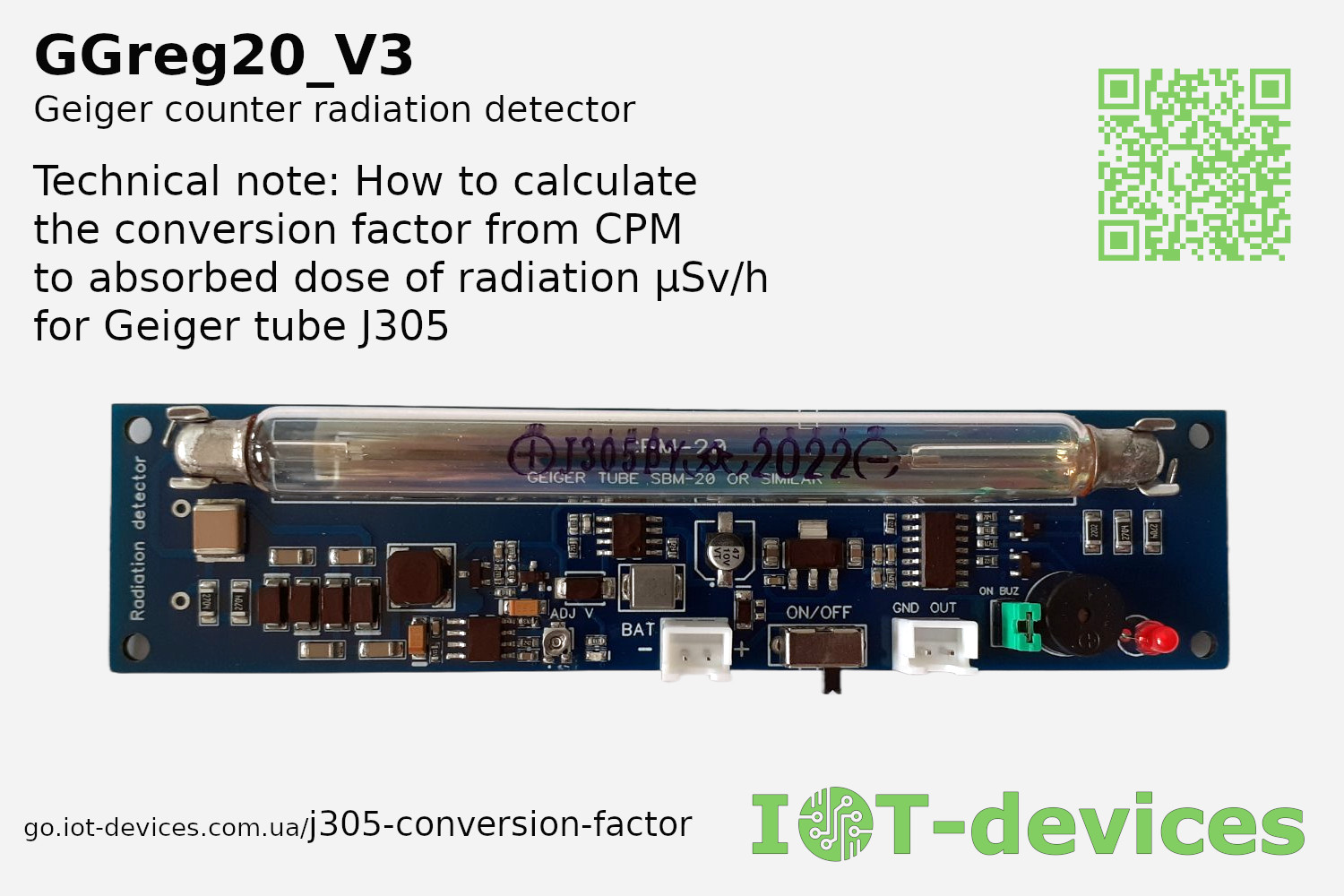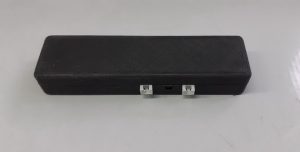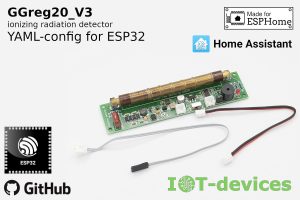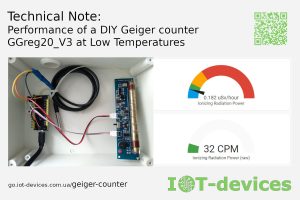We have already made a similar publication for the SBM20 Geiger tube. This time we bring to your attention an article dedicated to the equally popular J305 tube made in China.

According to our statistics, the J305 tube is second only to the Soviet-made SBM20 tube in terms of prevalence among DIY Geiger counter projects.
However, time passes, technologies improve, and supply chains change. New products and components are steadily occupying their niche on the shelves of electronics suppliers, gradually displacing temporary solutions from the market, which, in fact, was the Soviet SBM20 tube in the DIY electronics market.
If we were asked to compare SBM20 and J305 tubes, we would choose J305 for our project, as we have already mentioned in a separate publication. This article compares J305, SBM20, and LND712 tubes that we have worked with and with which the Geiger counter module GGreg20_V3 is electrically compatible.
This publication also describes the J305 tube as the closest and best alternative to the SBM20 tube, in our opinion. We will look at how to calculate the conversion factor for converting the number of pulses per minute of the J305 tube into the value of μSv/h, the equivalent dose of radiation absorbed by the human body.
| The main purpose of this publication is to correctly calculate and, if possible, understand where the conversion factor, such as 0.00812 for the J305 tube, comes from, which is published on the Internet. |
The Internet widely publishes data that the conversion factor for the J305 Geiger tube is 0.00812.
0,00812
As in the case of the SBM20 tube, we had to carefully search the Internet for the original source of this information. Unlike the investigation of the coefficient for SBM20, our search for data on J305 was successful and led us to the primary source of the common coefficient of 0.00812.
But let’s not get too far ahead of ourselves and set out everything in order.
Here are the general technical characteristics of the tubes so that we can look at them while studying the calculations that follow.
| SBM20 | J305 | LND712 | |
| Vendor’s calibration radioactive source | Cs-137 | Co-60 | Co-60 |
| Sensitivity | 60 – 70 counts / uR at 4 uR/s Cs-137 or 240-280 CPS at 4 | 44 CPS at 1 mR/h Co-60 | 18 CPS at 1 mR/h |
| Dead Time | 190 us | ? | 90 us |
| Background radiation level | 60 pulses/minute | 25 pulses/minute | ? |
| Internal background noise | 1 pulses/s or 60 pulses/minute | 0,2 CPS or 12 CPM | 10 CPM |
| Recommended operating supply voltage | 400 V | glass tube 380 V metal tube 400 V | 500 V |
Some formulas and calculations
As for the SBM20 tube, the calculation procedure for the J305 tube will be the same.
We will make calculations for J305 based on the manufacturer’s data.
The rate of event registration by the J305 tube at 1 μR/h from the Co-60 source is 44 pulses per second;
1. Let’s write down the initial data from the manufacturer’s datasheet. Pulses per second at 1 mR/hour:
44 pulses/s / mR/h
2. Convert to pulses per minute at 1 mR/h:
44 * 60 = 2640 pulses/minute / mR/hour
3. Convert to pulses per minute at 1 μSv/h:
2640 / 10 = 264 pulses/minute / μSv/h
or
264 pulses/minute = 1 μSv/h
or
1 pulses/minute = 1:264 μSv/h
4. Calculate the value of one pulse per minute:
1 / 264 = 0,00378
Thus, if we need to convert the pulses detected by the J305 tube during a minute to μSv/hour:
| μSv/h = pulses/minute * 0.00378 |
Everything would have been fine, and we could have stopped calculations there. But the coefficient we have just obtained
0,00378
gives us the exposure value recorded by the Geiger counter. We are primarily interested in the equivalent dose of radiation absorbed by the human body.
Therefore, let’s move on to the next part of the calculations.
| We are primarily interested in the equivalent dose of radiation absorbed by the human body, not the exposure dose registered by the device |
In order to estimate the equivalent dose of energy absorbed by the human body, science uses the so-called human body phantom model, which calculates certain conversion factors for converting one value to another.
If you are interested in reading the theory on this subject, we can advise you to read this publication:
We now proceed to derive the conversion factor for converting the CPM of the tube into an equivalent dose of absorbed radiation in microsieverts per hour, taking into account the phantom model of the human body.
Let’s start the calculation with the coefficient provided by the manufacturer in the documentation: 44 imp/s per 1 mR/h of Co-60.
J305 sensitivity to gamma rays: 44 CPS/mR/h
1. Let’s convert pulses/s to pulses/minute at 1 mR/h (we already have this value, but we are going to calculate it again for the reader’s convenience):
44 * 60 = 2640 pulses/minute / mR/hour
2. Convert CPM at 1 mR/h to CPM at 1 R/h:
2640 * 1000 = 2640000
3. Find the value of the exposure dose R/h per 1 CPM:
1 / 2640000 = 0.0000003787878788
4. Find the air-kerma (Ka, kinetic energy released per unit mass/in a substance):
The equation is as follows:
Ka [Gy] = 0.00877 [Gy/R] x exposure [R]
where 0.00877 is the coefficient of radiation dose absorption by the human body on the phantom model under the influence of photon energies of 100 keV – 3 MeV
Note . For the air-kerma equation and coefficients, see the link: the link: https://web.archive.org/web/20230402162906/https://www.automess.de/en/service/radiation-quantities-and-units
0.00877 * 0.0000003787878788 = 0.000000003321969697 Ka[Gy][Gy]
5. Convert Ka[Gy] to Ka[uSv] (i.e., switch from Gray to µSv):
0.000000003321969697 * 1000000 = 0.003321969697 Ka[uSv]
6. Perform the check and find the inverse value:
0.003321969697 ^(-1) = 301.0262258
Thus, the formula for the equivalent absorbed dose of radiation by the human body for the Geiger-Muller J305 tube with gamma sensitivity for Co-60 of 44 cps/mR/h is as follows:
| uSv/h = CPM x 0.00332 |
where
0.00332 μSv/h is the value of one count, pulses/min;
CPM is the number of counts (events) per minute detected by the Geiger tube.
| Lifehack (Quick formula): To get a factor of 0.00332, you can simply multiply the value of 44 imp/s / mR/h from the datasheet by 60 and divide by 8.77, and take the inverse. 1 / (44 * 60 / 8.77) = 1 / 301.0262258 = 0.003321969697 This is what we checked with such complex conversions above. Now you know where this coefficient comes from |
Something is wrong here
Well, an attentive reader will say, but where is the number 0.00812, which was mentioned at the beginning of the calculations?
You are right! We were also surprised: as a result of the calculations, we got the coefficient equal to 0.00332, but we expected that the calculation should result in a value of 0.00812. That is, a completely different number for the CPM to μSv/h conversion factor.
We started searching on the Internet and found it.
As it turned out, most of the examples of settings for the J305 tube simply refer to each other, but we did find out where this coefficient came from.
Follow the link (or here, in PDF on the Libelium website) to find a document with the following data:
“…The current version of the pack comes with the J305ß Geiger tube which detectes Beta and Gamma radiation.
Specifications:
Manufacturer: North Optic
Radiation Detection: β, γ
Length: 111mm
Diameter: 11mm
Recommended Voltage: 350V
Plateau Voltage: 360-440V
Sensitivy γ (60Co): 65cps/(µR/s)
Sensitivy γ (equivalent Sievert): 108cpm / (µSv/h)
Max cpm: 30000
cps/mR/h: 18
cpm/mR/h: 1080
cpm/µSv/h: 123.147092360319
Factor: 0.00812037037037…”
Everyone refers to this text and there is no way to verify the data, because the website of such a manufacturer as North Optic does not exist.
The most surprising thing is that respectable resources also publish (or allow users to do so) this coefficient without the note “Attention! No one knows where it came from.”
Note. Please contact us if you have any information on how to contact North Optic or explanations on the reliability of the 0.00812 coefficient. Thank you in advance. Thank you in advance.
As you can see, the original data provided by North Optic is very different from the data currently provided by Chinese manufacturers with their tubes.
For comparison, here is the datasheet for the J305 glass tube we have. These are the tubes that we use to equip the Geiger counter module GGreg20_V3:
| Fig. Characteristics of the J305 tube from the manufacturer’s datasheet |
Given the materials we found, it is at least clear where the numerical value of the conversion factor of 0.00812 comes from.
Look, from the mathematical point of view, everything is very simple:
[18 CPS / mR/h] x 60 / 8.77 = 123.1470923603193
1 / 123.1470923603193 = 0.0081203703703704
Here, we immediately applied a quick formula and obtained a conversion factor of 0.00812 for a tube with a sensitivity of 18 CPS / mR/h.
Indeed, if we assume that the tube has a sensitivity of 18 CPS / mR/h, then the coefficient should be exactly 0.00812.
But the 2022 J305 tube that suppliers sell through Alibaba in 2023, and that we hold in our own hands, has completely different properties. Declared by the Chinese manufacturer in the datasheet: 44 CPS / mR/h.
Conclusions
We provided a complete algorithm and showed how to calculate the conversion factor of CPM to the equivalent dose of radiation absorbed by the human body (uSv/h) for a Geiger tube such as J305.
We also considered two variants of the conversion factor.
The first is the one we calculated based on the data in the datasheet: 0.00332.
The second is the one that everyone uses: 0.00812
It is up to you to decide which conversion factor you prefer to use.
Examples for ESPHome
We would like to remind you that the GGreg20_V3 module is compatible with both tubes: SBM20 and J305.
On our GitHub , you will find several examples of ESPHome firmware configuration files for both SBM20 and J305 handsets. The difference is only in a few coefficients of these tubes:
- CPM -> uSv/h conversion factor;
- coefficient of compensation of internal noise of the tube (for cases when it is used).
Currently, ESPHome is a fairly common and popular platform with wide support for a variety of MCUs, such as ESP8266, ESP32, RaspberryPi Pico W, and others. That’s why most of the examples in our GitHub repositories are aimed at and based on the ESPHome firmware and Home Assistant server.
Where to order GGreg20_V3
You can order the Geiger counter module GGreg20_V3 on our website, as well as on one of our electronic platforms:
- Online shop: go.iot-devices.com.ua/shop
- Etsy store: go.iot-devices.com.ua/etsy
- Tindie store: go.iot-devices.com.ua/tindie
If ordered, the GGreg20_V3 module is equipped with several additional options to choose from. Among them:
- Geiger tube J305
- cables for connection to the MCU
- protective 3D printed plastic cover for GGreg20_V3
Please also note that you can also order the ESP12.OLED_V1 universal controller module (based on the ESP8266) on our website.
Both of these modules are sufficient to build a DIY Geiger counter with a display:
[GGreg20_V3] + [ESP12 .OLED_V1] = [DIY Geiger counter]
We hope that this and our other publications were useful and interesting.
Good luck!
Team IoT-devices, LLC


